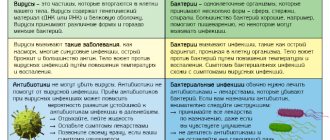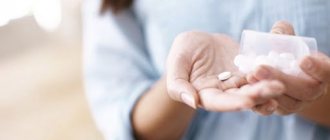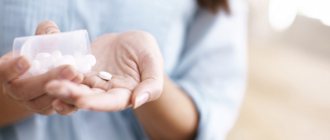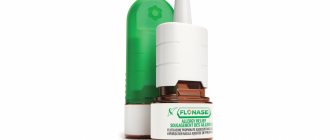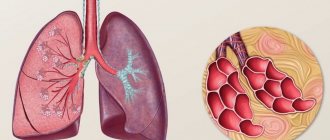Broad-spectrum antibiotics: TOP 20 best
The list of broad-spectrum antibiotics includes drugs from different groups. Drugs from a number of fluoroquinolones, nitroimidazoles, glycopeptides and from the phosphoric acid group have particularly high activity.
Below you can familiarize yourself with the characteristics of the best broad-spectrum antibiotics and methods of their use. Antibiotics are prescribed by the attending physician taking into account the sensitivity of the pathogen based on laboratory data. In some cases, urgent prescription of antibacterial agents is necessary, then the choice falls on broad-spectrum antibiotics.
With long-term treatment, bacterial resistance to antibiotics may develop; in this situation, it is necessary to change drugs to others or use a complex of several drugs. The duration of antibiotic therapy is determined by the severity of the disease, the presence of complications and concomitant pathologies. Doses of modern broad-spectrum antibiotics are selected by the attending physician individually, taking into account the patient’s age and possible contraindications.
How do new generation antibiotics work?
Unlike drugs from the antiseptic group, the antibiotic has a proper therapeutic effect not only after external application, but also acts systemically after oral, intravenous, and intramuscular use.
New generation antibiotics are capable of:
- Affect the synthesis of cell walls by disrupting the production of vital peptide complexes.
- Impair the functioning and integrity of the cell membrane.
- Disturb the synthesis of protein necessary for the growth and functioning of the pathogenic pathogen.
- Suppress nucleic acid synthesis.
Based on the nature of their effect on bacterial cells, antibiotics are divided into:
- Bactericidal - the pathogen will die and will then be eliminated from the body.
- Bacteriostatic - the active component does not kill bacteria, but disrupts their ability to reproduce.
It is important to determine how active the active substance of the drug is in relation to a particular pathogen of the pathological process. To do this, you need to undergo a series of laboratory tests prescribed by your doctor.
Can only be used as prescribed by a doctor
It is very important to take antibacterial agents only in cases where you cannot do without them. It is unacceptable to take medications on your own initiative. Indications for the use of antibiotics include various symptoms of infectious diseases that cannot be treated on your own:
- Prolonged high temperature.
- Purulent processes.
- Exacerbations after pathologies of a bacterial nature.
- Disturbance in the structure of the circulatory system. There is an increase in the level of white cells, an increase in ESR and other characteristic signs indicating inflammation.
It is worth remembering that antibacterial agents are not effective against viruses. Therefore, this pharmacological group is not prescribed to patients to combat influenza, ARVI, and intestinal infections.
Rules for prescribing antibiotics
In order for antibiotics to be as effective as possible and not give serious side effects, when selecting and prescribing them, it is necessary to take into account the form of the disease and its severity, as well as determine the cause of the pathology (ideally, using culture results, find out which microbe caused the inflammation).
In addition, it is important to determine the sensitivity of bacteria to certain antibiotics that are planned to be used. Naturally, this is difficult to do in pediatric practice, and there are conditions in which a delay of several days, which is spent on performing cultures and determining sensitivity to antibiotics, can become fatal.
These include acute otitis media, tonsillitis or pneumonia, pyelonephritis and some other conditions. In these cases, antimicrobial therapy is prescribed immediately, based on clinical recommendations and treatment protocols that have been developed over years of treatment. If necessary, therapy is adjusted based on culture results already during treatment, if it is ineffective.
The dispute in which a scientific discovery was born
The history of the invention of an antibiotic from mold fungi began in the 60s of the nineteenth century in Russia. Two scientists, Alexey Polotebnov and Vyacheslav Manassein, argued about the nature of the most ancient nuisance - mold, which is very difficult to fight. Polotebnov believed that mold acts as a kind of progenitor of all microbes living on Earth. Manassein categorically disagreed with this point of view - he believed that mold has a unique biological structure and is fundamentally different from other microorganisms.
To support his opinion with facts, Manassein began to study green mold and soon discovered that there were no colonies of bacteria in the immediate vicinity of its strains. From this, the scientist concluded that mold prevents microbes from multiplying and feeding. He shared the results of his observations with Polotebnov, who admitted he was wrong and set about inventing an antiseptic emulsion based on mold. With the resulting remedy, Manassein's former opponent was able to successfully treat skin infections and non-healing wounds.
The result of the joint research work of the two scientists was a scientific article entitled “The Pathological Significance of Mold,” which was published in 1872. But, unfortunately, the international medical community of that time did not pay due attention to the work of Russian specialists. And they, in turn, did not transfer their research to the development of a drug for internal use, and limited themselves to a local antiseptic. If not for these circumstances, who knows - perhaps a Russian scientist would have become the inventor of antibiotics.
Diseases and spectrum of action of antibiotics
Back in the late 19th century, bacteriologist Hans Gram discovered that different bacteria react differently to staining. Some acquire a pronounced color, while others, on the contrary, quickly discolor. This simple experience was of great importance from a practical point of view. After all, different reactions to the dye spoke about the properties of the bacterial cell wall. This means that it suggested exactly how antibiotics should act on the microorganism.
Since then, there has been a basic division into gram-negative (non-staining) and gram-positive (staining) bacteria.
- Gram (+) is the causative agent of most infections of the respiratory tract, nasopharynx, ear, and eye. These include, in particular, staphylococci and streptococci.
- Gram (-) - Bacteria in this group can cause serious illness. These are Escherichia coli, Koch bacillus, salmonella, shigella (the causative agent of diphtheria), gonococcus, meningococcus.
The spectrum of action of antibiotics is determined by which bacteria are sensitive to a particular drug. And if narrow-spectrum antibiotics more often act on either Gram (+) or Gram (-), then a wide spectrum allows them to affect both.
Broad-spectrum antibiotics: list of drugs
Broad-spectrum antibiotics are universal bactericidal drugs that will help get rid of many diseases. Most often they are prescribed for the treatment of various infections, the causative agent of which remains unknown. They are also prescribed if a person has become infected with a fast-growing and dangerous virus.
The list of modern antibiotics is presented in the table below:
| Group | A drug | Mechanism of action |
| Tetracyclines | Doxycycline, Tetracycline | Kills bacteria and has an antiviral effect |
| Levomycetin | Moxifloxacin, Levofloxacin | Antimicrobial, antifungal and antibactericidal |
| Semi-synthetic penicillins | Carbenicillin, Ticarcillin | Inhibits the synthesis of the pathogen cell wall |
| Cephalosporins | Ceftriaxone | Changes the activity of a virus that has entered the RNA |
| Rifampicins | Streptomycin, Amphenicol | Interferes with protein production |
| Carbapenems | Meropenem, Meropenem, Cyronem, Imipenem | Antibacterial and anti-inflammatory, prolonged action |
Also, such drugs may be indicated as prophylaxis after major surgical interventions. Remember that not all cheap drugs are so bad.
Which brand of antibiotics is better to choose?
Often the same drug is produced by different pharmaceutical companies, so their composition and dosage may differ slightly. Doctors can advise the patient which manufacturer’s medication to buy so that the treatment is more effective. The best antibiotics are produced by the following companies:
- Astellas Pharma Europe is the Dutch representative office of a Japanese public company, which was founded through the merger of 2 pharmaceutical companies. In the 1970s they opened offices in Europe and the USA. In 2005, they merged and the headquarters were located in Tokyo. The company's mission is to improve people's health through the production of innovative and reliable medicines.
- KRKA is an international pharmaceutical company headquartered in Slovenia. Founded in 1954 as a small laboratory. Produces generic drugs. Their active ingredient is the same as the original, but the composition contains other auxiliary components. The company's factories are located in Germany, Poland, Russia, Croatia, and Slovenia.
- Dalkhimpharm is the legal successor of the Khabarovsk Chemical Plant, which was founded in 1939. It is considered one of the oldest drug production enterprises in Russia and is one of the country's top ten pharmaceutical manufacturers. The main principle of work is to provide clients with effective, high-quality and safe drugs. All products are tested by the Moscow quality control center.
- Sandoz is a pharmaceutical company founded in Germany by Eduard Sandoz and Alfred Kern in 1886. It produces generics that are used in the treatment of various diseases. Products are represented in the markets of more than 140 countries. Now it is one of the top three producers of amoxicillin.
- Laboratoires Bouchara -Recordati – founded in Italy in 1926. In 1999 and 2000, he acquired pharmaceutical companies in France, at whose factories he began production of the antibiotic framycetin under the trade name Isofra. The company's products are represented in the markets of Europe, the USA, Canada, South America, and North Africa. The company's goal is to improve the quality of life of people.
- JSC FP "Obolenskoe" is a Russian company, created on the basis of the State Scientific Center for Applied Microbiology in 1994. Since 2013, it has been part of the Alvansa group of companies. The quality of products, according to the results of external audits, meets international standards. The company produces more than 150 drugs of various pharmacotherapeutic groups. Among them there are generics and innovative developments.
- Pliva is the largest pharmaceutical company in Southern Europe with its head office in Zagreb, Croatia. Founded in 1921, since 2008 acquired by TEVA and operates as its department. The main activity is aimed at the development and production of generics. The most popular antibiotic of this company is Sumamed.
- GlaxoSmithKline is a British pharmaceutical company founded in 2000 through the merger of two companies. Representative offices are opened in Germany, Italy, Australia, Canada, Poland and other countries. The main factories are located in Singapore, USA, UK, Spain. Products are represented on the markets of 160 countries. A popular drug from this company is considered a strong broad-spectrum antibiotic Augmentin.
- PJSC Biosintez is a group of companies that includes the largest Russian pharmaceutical enterprises. Founded in Penza in 1955. The first antibiotic was released in 1959. It ranks 5th in the world in the production of generic drugs. The quality of medicines is recognized in 150 countries.
- Olain Farm is the largest pharmaceutical company in the Baltic countries, founded in 1972. The headquarters is located in Latvia. The quality of the products is confirmed by audits of well-known companies in Switzerland, the USA, and France. In the territory of the former USSR, the company became the first whose drug was included in the WHO list.
- Synthesis is a Russian plant, created on the basis of the Kurgan Medicinal Products Plant for the production of antibiotics. Also produces vitamin B12 and endocrine drugs. Since 1987, engineers have introduced new technology for producing ampicillin trihydrate.
Cephalosporins
Active against staphylococcal infections, as well as Proteus, Klebsiella, E. coli, pathogens of sore throat and pneumonia, urinary tract diseases, osteomyelitis, meningitis.
Antibiotics in this group include:
Parenteral 3rd generation:
| Representatives | Trade name and method of application |
| Cefotaxime | Klaforan : powder for injection solution: 0.5-2.0 g. x 1 time per day intramuscularly or intravenously slowly. Cefosin : powder for injection solution: 1.0 g each. every 8-12 hours intramuscularly, intravenously slowly/drip. |
| Cefoperazone | Cephobid : powder for injection solution: 2.0-4.0 g. per day for 2 intramuscular injections. Cefpar : powder for injection solution: 2.0-4.0 g each. every 12 hours intravenously/intramuscularly. |
| Ceftriaxone | Ceftriaxone : powder for injection solution: 1.0-2.0 g. x 1 time per day intramuscularly/intravenously. Azaran : powder for injection solution: 1.0 g. dissolve in 3.5 ml of 1% solution of lidocaine hydrochloride, intramuscular injections 1 time per day. |
| Ceftazidime | Fortum : powder for injection solution: 1.0-6.0 g each. x 1 time per day for 2-3 intravenous/intramuscular infusions. Ceftidine : powder for injection solution: 1.0-6.0 g. x 1 time per day intravenously/intramuscularly. |
Parenteral 3rd generation:
| Representatives | Trade name and method of application |
| Cefditoren | Spectracef : tablets: 0.2-0.4 g. x 2 times a day. |
| Ceftibuten | Tsedex : capsules: 0.4 g each. once a day. |
| Cefixime | Suprax Solutab: effervescent tablets: 0.4 g each. x 1 time per day or 0.2 g. x 2 times a day, dissolve in advance in a glass of water. Suprax: capsules: 0.4 g each. x 1 time per day. Pancef : tablets: 0.4 g each. once a day or 0.2 g. twice a day. |
5th generation (parenteral):
| Representatives | Trade name and method of application |
| Ceftaroline | Zinforo : powder for injection solution: 0.6 g. every 12 hours intravenously for an hour. |
| Ceftobiprole | Zeftera : lyophilisate for injection solution: not used in the Russian Federation. |
Macrolides
Macrolides tend to accumulate in tissues, and not in blood serum, like other groups. They are used in the treatment of bronchitis and community-acquired pneumonia as a monomedicine (in case of intolerance to penicillins), pathologies of the ENT organs (pharyngitis, sinusitis, otitis, laryngitis and others) and sexually transmitted diseases (syphilis, gonorrhea, benorrhea).
Antibiotics in this group include:
14-member:
| Representatives | Trade name and method of application |
| Erythromycin | Erythromycin:
|
| Oleandomycin | Oleandomycin phosphate : powder substance. Practically not used at present. |
| Roxithromycin | RoxyHEXAL: tablets: 0.15 g each. twice a day or 0.3 g. at one time, the course is taken for 10 days. Esparoxy: tablets: 0.15 g each. twice a day 15 minutes before meals or 0.3 g. once, the course of administration is 10 days. Rulid : tablets: 0.15 g each. twice a day, course of treatment is 10 days. |
| Clarithromycin | Klacid: tablets: 0.5 g. twice a day, taken for 2 weeks. Fromilid: tablets: 0.5 g twice a day, taken for 2 weeks. Clarithrosin : tablets: 0.25 g. twice a day, taken for 2 weeks. |
15-member:
| Representatives | Trade name and method of application |
| Azithromycin | Sumamed: capsules: 0.5 g each. x 1 time per day before or 2 hours after meals. Azitrox: capsules: 0.25-0.5 g each. x 1 time per day. Azitral : capsules: 0.25-0.5 g. x 1 time per day before or after meals. |
16-member:
| Representatives | Trade name and method of application |
| Spiramycin | Spiramycin-vero : tablets: 2-3 tablets (3 million IU) in 2-3 doses per day. Rovamycin : tablets: 2-3 tablets (3 million IU) or 5-6 tablets (6-9 million IU) for 2-3 doses per day. |
| Josamycin | Vilprafen : tablets: 0.5 g. twice a day, without chewing, with water. Vilprafen solutab : tablets: 0.5 g each. x twice a day, without chewing or dissolved in 20 ml of water. |
| Midecamycin | Macropen : tablets: 0.4 g each. three times a day, course of administration for 2 weeks. |
Aminoglycosides
The first generation is used in the treatment of plague and tuberculosis only in combination with tetracycline. Third and fourth for tuberculosis, sepsis, severe hospital infections such as pneumonia.
Antibiotics in this group include:
1st generation:
| Representatives | Trade name and method of application |
| Neomycin | Neomycin : external aerosol: on the affected areas of the skin, shake well and place the balloon at a distance of 15-20 cm, apply for 3 seconds; Repeat application 1-3 times a day. |
| Streptomycin | Streptomycin : powder for injection solution: 0.5–1.0 g. x 2 times a day intramuscularly. To prepare the solution, use sterile water/saline solution/0.25% novocaine. Calculation: per 1.0 g. medications - 4 ml of solvent. Streptomycin sulfate . Substance-powder: for intramuscular administration - 0.5-1.0 g. per day. For intratracheal/aerosol administration – 0.5-1.0 g. x 2-3 times every 7 days. |
| Kanamycin | Kanamycin : powder for injection solution: 1.0-1.5 g. for 2-3 injections intravenously (a single dose (0.5 g) is dissolved in 200 ml of a 5% dextrose solution). Kanamycin sulfate : for intramuscular administration 0.5 g./1.0 g. dissolve in 2/4 ml of sterile water or 0.25% novocaine. For intravenous administration 0.5 g. dissolve in 200 ml of saline or 5% glucose solution. |
2nd generation:
| Representatives | Trade name and method of application |
| Tobramycin | Tobrex: eye drops: 1-2 drops, pulling back the lower eyelid, every 4 hours; for severe eye infections - 2 drops every hour. Tobriss: eye drops: 1 drop, pulling back the lower eyelid, 2 times a day (morning and evening); for severe eye infections - 1 drop x 4 times a day. Bramitob : solution for inhalation: 1 ampoule of medication (0.3 g) every 12 hours, administered by inhalation using a nebulizer, course 28 days. |
| Gentamicin | Gentamicin : solution for injection: 0.003-0.005 g. per 1 kg of weight for 2-4 injections, administered intravenously/intramuscularly. Eye drops: 1-2 drops every 1-4 hours, retracting the lower eyelid. Ointment: 3-4 applications per day to affected areas of the skin. Gentamicin sulfate : powder up to 1.2 mg per 1 kg of body weight per day for 2-3 injections (urinary infections); 2.4-3.3 mg per 1 kg of body weight per day for 2-3 injections (severe infections, sepsis). Administer the medicine intramuscularly/intravenously. |
3rd generation:
| Representatives | Trade name and method of application |
| Framycetin | Isofra : nasal spray: 1 injection into each nasal passage x 4-6 times a day, course no more than 10 days. |
| Spectinomycin | Kirin : powder for making a suspension: 2.0 g each. (5 ml)/4.0 g. (10 ml) deep intramuscularly into the upper outer part of the buttock. To prepare the suspension, you need to add 3.2 ml of sterile water to the vial. Suspension for single use, storage is prohibited. |
| Amikacin | Amikacin: solution for infusion: 0.01-0.015 g. per 1 kg of body weight per day for 2-3 injections, administered intramuscularly/intravenously (stream, drip). Amikacin sulfate: substance-powder: 0.005 g each. per 1 kg of weight every 8 hours or 0.0075 g. per 1 kg of body weight every 12 hours, administered intramuscularly/intravenously. |
| Netilmicin | Nettacin : eye drops: 1-2 drops, pulling back the lower eyelid, 3 times a day. Vero-Netilmicin : solution for injection: 4-6 mg per 1 kg of body weight per day intravenously/intramuscularly; for severe infections, the daily dose can be increased to 7.5 mg per 1 kg. |
Carbapenems
As a rule, we encounter carbapenems extremely rarely or not at all. And this is wonderful - after all, these antibiotics are indicated for the treatment of severe hospital infections that threaten life. The spectrum of action of carabapenems includes most existing pathological strains, including resistant ones.
Antibiotics in this group include:
| Representatives | Trade name and method of application |
| Doripenem | Doriprex : powder for injection solution: 0.5 g each. intravenously every 8 hours. To prepare the solution, the powder must be dissolved in 10 ml of isotonic sodium chloride solution, the resulting mixture should be added to a bag with 100 ml of isotonic sodium chloride solution or 5% glucose solution. |
| Ertapenem | Invanz : lyophilisate for injection solution: 1.0 g each. per day, administered in 1 injection intravenously/intramuscularly. |
| Meropenem | Meronem: powder for injection solution:
The medicine is administered intravenously slowly (within 5 minutes; the solution is prepared by adding 5 ml of sterile water per 250 mg of the drug) or intravenously drip (within 15-30 minutes; the solution is prepared by adding 50-200 ml of isotonic sodium chloride). Meropenem : powder for injection solution:
|
| Imipenem + cilastatin | Tsilaspen: powder for injection solution: the method of preparing the solution and using it is similar to the above. Tiepenem: powder for injection solution: 1.0-2.0 g. per day, administered intravenously in 3-4 infusions. To prepare the solution, you need to add isotonic sodium chloride to the bottle in a ratio of 100 ml of sodium chloride per 0.5 g. drug, shake until completely homogeneous. Tsilapenem : powder for injection solution: 1.0-2.0 g. per day, administered intravenously in 3-4 infusions. To prepare the solution, add 100 ml of isotonic sodium chloride to the bottle and shake until smooth. Tienam : powder for injection solution: 2.0 g each. per day, administered in 4 injections intravenously/intramuscularly. |
Penicillins
With the discovery of an antibiotic of this particular group - Benzylpenicillin - doctors realized that microbes could be defeated. Despite its venerable age, benzylpenicillin is still used today, and in some cases it is a first-line drug. However, broad-spectrum agents include other, newer penicillin antibiotics, which can be divided into several groups.
| Representatives | Trade name and method of application |
| Ampicillin | Ampicillin:
|
| Amoxicillin + clavulanic acid | Amoxiclav: tablets: 1 tablet (250+125 mg) three times a day or 1 tablet (500+125 mg) twice a day; take with food, course of treatment for 2 weeks. Powder for suspension: use the attached tables to calculate the dose of the medicine. Augmentin: tablets: 1 tablet (250+125 mg) three times a day, course of administration for 2 weeks. Powder for suspension: add 60 ml of clean water at room temperature to the bottle with the powder, wait 5 minutes, add the volume of water to the mark on the bottle, mix. Flemoclav Solutab : tablets: 1 tablet (500+125 mg) three times a day or 1 tablet (875+125 mg) twice a day; do not chew, take at the beginning of meals, take the course for 2 weeks. |
| Amoxicillin | Flemoxin Solutab: tablets: 0.5 g. twice a day, course of administration for 2 weeks. Amoxicillin: tablets: 0.5 g. twice a day, course of administration for 2 weeks. Amosin : capsules: similar regimen and duration of administration. Powder for suspension: pour the powder from the bag into a glass with warm, clean water, stir. |
Taking probiotics
Everyone knows that antibacterial drugs have a detrimental effect on the intestinal microflora, especially with long-term use. Therefore, during the course of treatment you should additionally take probiotics and consume various dairy dishes. It is advisable to take such medications between intervals of taking the main drug.
Effective representatives of probiotics: Linex, Bifiform, Acipol, Normoflorin. It is advisable to consult a doctor about choosing the appropriate remedy.
Fluoroquinolones
Probably, no doctor can imagine his medical practice without fluoroquinolone antibiotics. The first synthesized representatives of this group were distinguished by a narrow spectrum of action. With the development of pharmaceuticals, new generations of fluoroquinolone antibacterial agents were discovered and the spectrum of their activity expanded.
Antibiotics in this group include:
| Representatives | Trade name and method of application |
| Sparfloxacin | Sparflo : tablets: 0.1-0.4 g. per day (depending on the type and severity of the infection). |
| Gatifloxacin | Gatispan : tablets: 0.4 g. x 1 time per day, without chewing, course 10 days. |
| Moxifloxacin | Moflaxia : tablets: 0.4 g. x 1 time per day, without chewing, course 14 days. Avelox : tablets: 0.4 g. x 1 time per day, without chewing, course 14 days. |
| Levofloxacin | Tavanik: tablets: 0.25 gr. (2 tablets) twice a day or 0.5 g. (1 tablet) 1 time per day with water, course 14 days. Floracid : tablets: 0.5 g. twice a day, without chewing. |
Antibiotics for sore throat, bronchitis and cough
Inflammatory diseases of the upper respiratory tract are among the most common in clinical practice. Both children and adults are susceptible to diseases such as tonsillitis and bronchitis. Sometimes these pathological conditions can be caused by viruses, but often a bacterial infection is also associated. In this case, it is necessary to use antibacterial drugs (antibiotics). It should be recalled that antibiotic therapy should be carried out only after a complete examination of the patient, diagnosis and testing of the sensitivity of the flora to a particular antibiotic.
The following medications may be prescribed to treat these diseases:
| Name and group of the drug | Dosage |
| Flemoxin Solutab. Penicillin group, active ingredient – Amoxicillin. |
|
| Sumamed. A group of macrolides, the active ingredient is Azithromycin. |
|
| Gatispan. A group of fluoroquinolones, the active substance is Gatifloxacin. | 1 tablet 400 mg per day. |
| Avelox. A group of fluoroquinolones, the active substance is Moxifloxacin. | 1 tablet 400 mg per day. |
| Rulid. A group of macrolides, the active ingredient is Roxithromycin. | Adults and children weighing over 40 kg – 2 tablets of 150 mg 1-2 times a day. In other cases, the dosage is calculated individually. |
| AzitRus. A group of macrolides, the active ingredient is Azithromycin. | Adults and children over 12 years old – 1 capsule or tablet of 500 mg per day. Children over 3 years old – 10 mg per 1 kg of weight per day. |
The addition of a bacterial infection may be indicated by a sharp increase in body temperature, an increase in signs of general intoxication (weakness, headache and muscle pain, dizziness), cough with the discharge of purulent sputum.
Allergy
Of course, one of the most common side effects of antibiotics is allergies. 5 In this case, an itchy rash and swelling may appear on the skin. In severe forms, the eyelids, lips and tongue become swollen, there is difficulty swallowing and speaking, severe weakness appears, heaviness is felt behind the sternum and shortness of breath even at rest. This is how anaphylactic shock manifests itself - an acute pathological condition that is life-threatening. In case of rapid development of allergy symptoms, emergency medical care and resuscitation measures are necessary.
It is also necessary to take into account the fact that antibiotics can enter our body along with some food products - for example, meat may contain penicillins. This means that almost every person has a risk of developing allergies when taking antibacterial drugs. 6 This once again indicates the need for medical supervision when taking antibiotics.
Principles for selecting the best antibiotics for children
In order for antibiotics to be as effective, safe and free of side effects as possible, it is important to follow certain principles and rules when prescribing them.
Then the antibiotics selected by the doctor will be the best in treating the pathology:
- antibiotics are prescribed only for a proven microbial infection or with a high chance of its development, for complicated forms of pathologies, when the risks of adverse outcomes of the disease are high
- drugs are selected according to the most likely pathogens in a given region and for a given age, based on their resistance to certain drugs
- it is important to take into account previous episodes of antibiotic treatment, if they were carried out in the previous three months, to exclude carriage of resistant strains
- When prescribing drugs in outpatient practice, only oral forms are applicable; injections are prescribed only for special indications.
Drugs that have potentially toxic effects are prohibited for home treatment - a group of aminoglycosides, chloramphenicol, fluoroquinolone drugs and biseptol. When selecting antibiotics for complex clinical situations, it is also important to take into account age restrictions - for example, for tetracyclines, which are permissible only from 12 years of age, since earlier periods of their use threaten serious health consequences.
Possible complications
Despite all the benefits that a broad spectrum of antibiotics provides, such medications cannot be considered a panacea. Their uncontrolled use can affect health.
In particular, the following complications arise:
- According to some data, children who took broad-spectrum antibiotics in the first year of life are more susceptible to developing asthma.
- Improper use of antibiotics can lead to decreased sensitivity to drugs. This is often observed in people who did not complete the full course of therapy, but stopped treatment before the period specified by the doctor. In this case, the antibiotic managed to kill only weak and sensitive bacteria. The remaining ones begin to multiply, cause a new round of disease, but can no longer be treated with the original antibiotic.
- Long-term use of some drugs leads to serious complications. Penicillins can have a toxic effect on the central nervous system, and streptomycin can damage the auditory nerve.
- Destruction of beneficial microflora and subsequent problems with the gastrointestinal tract. Broad-spectrum antibiotics destroy all bacteria, including those we need. Therefore, probiotics or prebiotics are often prescribed along with them, which help maintain normal intestinal health.
Therefore, the universal spectrum of action of antibiotics is not at all a reason to treat them yourself. Only a doctor can select the appropriate drug, prescribe doses, and prescribe the duration of the course. And, of course, it is the specialist who determines the advisability of taking antibiotics as such.
Accounting for medications used
It is advisable to keep records of all antibiotics used. Namely, it is worth recording the duration of the course, the name of the medicine, when it was taken and for the treatment of what disease. This is recommended not only for children, but also for adults.
During use, you need to take into account the body’s reaction to the drug, the development of possible side effects, and allergies. This will help the doctor adequately assess the situation and prescribe the most effective antibacterial agent.
It is also important to warn the specialist about the use of additional drugs that have been used recently or currently.
Bottom line
Antibiotics are powerful substances of natural, synthetic or semi-synthetic origin that help suppress the growth and activity of pathogenic microorganisms.
Broad-spectrum drugs are effective against most bacteria at the same time, and their new generation causes minimal harm to the body.
The selection of a suitable drug depends first of all on the diagnosis, then on its mechanism of action, the degree of toxicity and pharmacokinetic properties. Independent selection and use of antibacterial drugs is dangerous and unacceptable.
Tetracyclines - time-tested antibiotics
Tetracycline antibiotics
- broad-spectrum drugs.
They are based on a four-cycle system. They do not have a beta-lactam ring, so they are not exposed to the pathogenic influence of beta-lactamase. Such drugs are prescribed for therapy:
- listeria, staphylococci, streptococci, clostridia, actinomycetes;
- gonorrhea, salmonella, whooping cough, syphilis, shigella, E. coli and klebsiella.
The advantage of broad-spectrum tetracycline antibiotics over their analogues is their ability to penetrate deep into the cell affected by the bacteria. It is for this reason that this remedy is actively prescribed to people with chlamydia, fungal infections, and ureaplasma. It should be noted that tetracyclines are absolutely ineffective in the fight against Pseudomonas aeruginosa. The most popular drugs are Doxycycline and Tetracycline.
